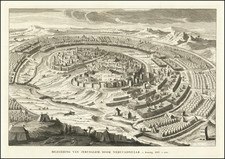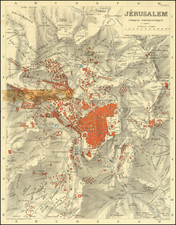Solomon's Jerusalem
Ierusalem qualis (ut plurimum) extitit atate Solomonis, executed by Thomas Fuller in London around 1650, offers an intricate representation of Jerusalem as conceived during the era of King Solomon. The depiction, with its grid-like arrangement, elucidates the walled city in detail, indicating primary entrances and highlighting edifices and monuments of significance from Solomon's epoch.
In the mid-17th century, there was an increased interest in the biblical past, often spurred by theological debates and religious schisms during the English Reformation and subsequent Civil Wars. Jerusalem, as the center of religious history, was a city of great interest to scholars, theologians, and the general populace. Fuller's interpretation, while primarily focusing on the Solomonic period, intriguingly incorporates the scene of crucifixions on Mount Calvary—a historical anachronism that could be seen as an effort to bridge the Old and New Testament narratives or perhaps cater to the Christian audience of his time.
The city's layout, combined with key monuments from Solomon's reign, offers viewers a synthesized vision of biblical history, making it more than a mere geographic representation but rather a fusion of theology and cartography. An additional layer of historical context is provided by the inclusion of the coat of arms of Edward Montagu, 1st Earl of Sandwich. His notable positions, especially as a General at sea and member of the English Council of State under Oliver Cromwell, as well as his eventual alignment with the restoration of Charles II, offer a glimpse into the complicated political and social tapestry of mid-17th century England.
The dedication, "Eduardo Montagu Armigero… Hierofolymarum Typu dedico TF," serves as a poignant testament to Montagu's patronage and his role in fostering arts and scholarship during a time of significant political and social upheaval. The mention of Montagu's patronage to the "languid" Fuller and his support in educating Fuller's son emphasizes the interconnectedness of cartography, politics, and personal narratives in the production of such works.












![(Czech Edition) Konterfekt Swatého Města Geruzaléma [A Depiction of the Holy City of Jerusalem]](https://storage.googleapis.com/raremaps/img/small/93469.jpg)
![(Jerusalem - Temple of Salomon) Templum Salomonis [with Perugia on verso]](https://storage.googleapis.com/raremaps/img/small/96662.jpg)
![[Jerusalem] Prospectus Sanctae olim et celeberrimae Urbis Hierosolymae . . . / Prospect der vormals Heiligen und Welt Berühmtem Stadt Jerusalem . . .](https://storage.googleapis.com/raremaps/img/small/84909.jpg)